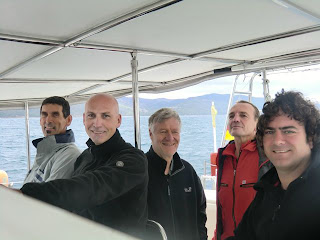After some more tourist activities like duty free shopping and more climbing of ‘the Rock’ we scheduled our departure for the 11/11/11, yet after a thorough check of all available weather data we decided to postpone for one more day. We left the following morning with more favourable easterly winds and currents making our passage through the busy Strait of Gibraltar ‘a breeze’. With winds of 15-20 knots we sailed close to the Spanish coastline in a westerly current zone with an outgoing tide and flew past Tarifa, the most southerly tip of the European continent and a well known wind and kite surf spot [and we know now why ….] by about midday. By 2pm we were ready to cross the traffic separation zone of the strait and found a gap in the continuously moving line of ships going east or west and headed for the Moroccan coastline.
All went smooth, the winds were great and to top this day off we caught our first tuna just as we were leaving the strait. That night we were buzzing and enjoyed a good tuna steak served with potatoes dug by August in his garden in Austria a few days earlier and crispy vegetables. What more can you ask for …… of course - the Spanish red wine, one glass each.
The tail fin of the tuna is drying at the stern of the boat and I am still trying to determine which colour it was, blue or yellow. In any case it will be used as bait for the next catch.
Soon the gods or better, the environment rudely changed the kind of euphoric atmosphere of the first day. As expected and forecast the wind changed to the south west, which meant 2 days of very uncomfortable head wind and big choppy sea. Outside Casablanca we were approached by a fishing vessel calling us on the VHF radio, kindly warning us of the inclement weather ahead and advising us to seek shelter in port. The idea of approaching Moroccan authorities and an unknown coastline in the dark sounded even less exiting and we continued. During the following 48 hours we hardly made progress down the Moroccan coast and during a change of watch entered the same log twice into the logbook, meaning we were working hard, but standing still. Rather than continue this uncomfortable ride we decided to go off course a bit and headed towards the coast to get a better angle into the oncoming swell. This improved things slightly, but we paid for it soon after. The boat suddenly came to a stand still and as it turned out we caught a fishing net in our propeller. Luck was on our side though and after some wet and rocky negotiations on the back steps using the hook we caught the tuna with and a sharp bread knife we could cut through the lines of the net and free the propeller of the remaining bits. We decided to head further out again to lower the risk of getting tangled again.
As the weather continued to be rough and the condition of the crew deteriorated a bit the second part of the tuna was turned into a warm and comforting soup. The weather grib files we downloaded promised more favourable winds and the following day the sun came out again, time to clean up you know what. For a while the wind was undecided which way to go and we needed to start the engines to motor a bit. Unfortunately this lead to more unexpected complications. Suddenly a distinct metallic smell came out of the port engine room and after investigating it the cause turned out to be an alternator problem. We motored on with the starboard engine and as the swell settled down a bit we attempted to exchange the alternator with our spare one. Not something you want to do every day out on the open sea, unless you really have to. We put the faulty one to rest in its box, may be for further investigation later.
After all that was resolved the winds came up again and from day 4 to 7 we got into the watch-and-sleep routine. The crew felt much better again and the last part of the tuna was turned into a delicious pasta dish served with a leafy green salad.
With north to north-westerly winds and swell from behind we sailed down towards the Canary Islands with continuous 6 to 9 knots. With the wind from abaft we poled out the genoa and tried out our newly installed inner forstay. We butter-flied our second genoa to make good speed. What a difference to 0-1 knot against the wind. Although we were going well we still had to let pass some larger yachts with more serious canvas. Now that we saw the yachts leaving Las Palmas with the ARC [Atlantic Rally for Cruisers] we know that one of them at least was participating in the racing division of the rally, making us feel better.
During the next days larger shoals of dolphins visited us again. Their incredible agility in the water and their obvious joy in weaving around each other and in and out from underneath the bows is a great spectacle one really never tires to watch.
We passed the islands of Lanzarote and Fuerteventura. Initially we had in mind to stop there for a day, but with the loss of time during first few days we now adjusted course directly towards Las Palmas on the island of Gran Canaria.
We knew the marina would be completely full as the ARC flotilla of more than 250 boats were taking up all of the space there, so we put down anchor at 0330 hrs on November outside the break walls and went for a well deserved and quiet sleep.
We were greeted the next morning by a sea of colourful flags in the marina.















































